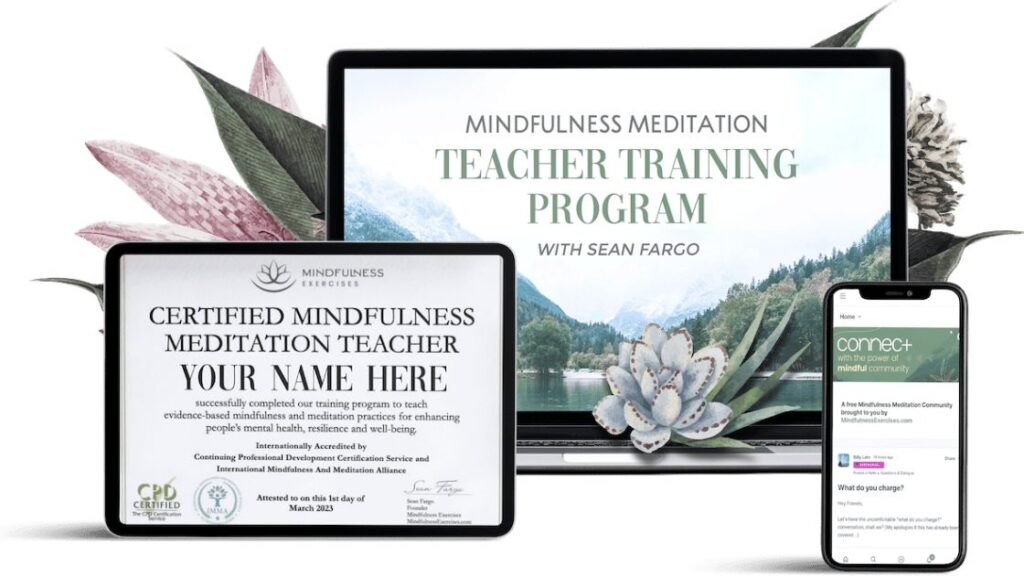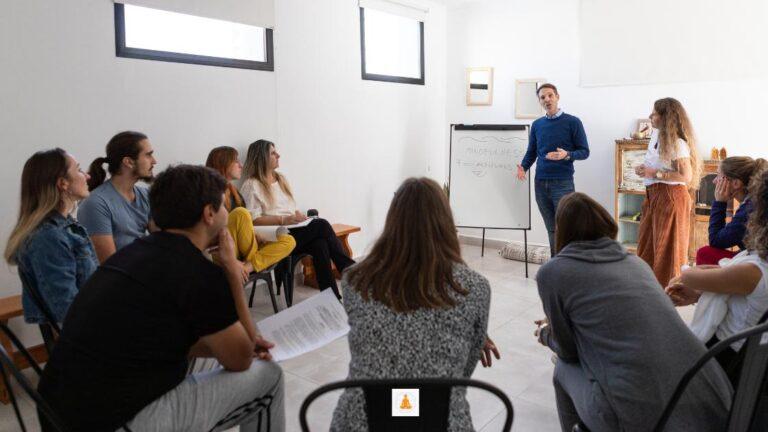Are you aspiring to become a mindfulness teacher or coach, but unsure where to start? Finding the right mindfulness teaching resources can be a game-changer. Whether you’re just starting out or looking to deepen your expertise, having the right tools and guidance can make a world of difference in how effectively you teach mindfulness to others.
In this post, we’ll explore the key mindfulness teaching resources you need to get started, including trusted training programs and customizable curriculums. By the end, you’ll have a clear understanding of the best resources available to help you confidently start your mindfulness teaching journey.
What Does It Mean to Teach Mindfulness?
Teaching mindfulness goes far beyond simply guiding people through meditation or mindful breathing exercises. At its core, being a mindfulness teacher means building a deeper connection between individuals and their inner awareness. So, what exactly are the responsibilities of a mindfulness teacher, and what does it take to be successful in this role?
Key Responsibilities of a Mindfulness Teacher
- A mindfulness teacher’s primary role is to guide others in cultivating awareness, self-compassion, and emotional resilience.
- This involves teaching individuals how to become more present in their daily lives, manage stress effectively, and respond to challenging situations with greater clarity.
- Whether you’re working one-on-one, in group settings, or in specialized environments such as schools or workplaces, your responsibility is to offer practical tools that help others integrate mindfulness into their own lives.
The Importance of Personal Practice Before Teaching
- Before you can effectively teach mindfulness to others, it’s essential to have a strong personal practice. Why? Because mindfulness is not just a set of techniques — it’s a way of being.
- When you engage in a regular personal practice, you cultivate the ability to remain present, grounded, and compassionate, even in challenging moments.
- This deep understanding allows you to teach authentically, offering wisdom that comes from your own experience.
- A well-rounded personal practice also helps you stay balanced, reducing the likelihood of burnout while teaching others.
Essential Qualities of a Successful Mindfulness Teacher
- Empathy: To teach mindfulness, you must first understand the emotional and mental challenges your students are facing. Empathy allows you to connect with them on a human level, helping to create a safe, nurturing environment.
- Patience: Mindfulness is a gradual journey. Patience ensures that you can support your students at their own pace, offering encouragement without rushing the process.
- Presence: One of the most important aspects of teaching mindfulness is modeling presence. By staying fully present with your students, you show them the power of mindfulness in action.
- Clarity: Mindfulness practices can seem abstract to beginners, so having the ability to explain concepts with clarity is crucial. Simplifying complex ideas without losing their depth is a key skill in any successful teacher’s toolkit.
How Resources and Training Boost Confidence & Effectiveness
- Teaching mindfulness is a skill that requires not only personal dedication but also the right training and resources.
- Whether you’re learning how to structure classes, manage different group dynamics, or introduce mindfulness to specific populations, high-quality resources can make a world of difference.
- When you are equipped with the proper tools and training, your confidence as a teacher grows, and so does your effectiveness.
The Basics You Need Before You Start Teaching
Before stepping into the role of a mindfulness teacher, it’s essential to build a solid foundation. Having access to the right books, articles, and resources can give you the knowledge and insights necessary to support your own mindfulness journey, as well as guide others effectively. But beyond self-study, those aspiring to teach mindfulness professionally should also consider formal training to ensure they have the skills and confidence to teach with integrity and expertise.
The Need for Formal Training to Teach Mindfulness Professionally
- While foundational resources are invaluable, those who wish to teach mindfulness professionally should go beyond self-study.
- Formal training programs provide structure, guidance, and the skills needed to lead classes, workshops, or one-on-one sessions effectively.
- Teaching mindfulness requires more than simply knowing the techniques—it involves understanding the science behind mindfulness, learning how to manage group dynamics, and developing the ability to respond to students’ unique needs.
- These training programs also cover how to create a safe, inclusive environment where students feel supported in their practice.
- This is especially important if you’re working with vulnerable populations, such as individuals dealing with trauma or chronic stress.
- Professional training ensures that you approach mindfulness teaching ethically and responsibly.
For aspiring mindfulness teachers looking for a structured, comprehensive training program, the Sean Fargo’s Mindfulness Teacher Training Program offers an excellent pathway.

Looking to Teach Mindfulness with Confidence?
Sean Fargo’s Mindfulness Teacher Training Program offers the perfect blend of theory and practical tools to help you succeed, whether in schools, workplaces, or private sessions.
Why a Structured Curriculum Is Key to Successful Teaching
When it comes to teaching mindfulness, having a structured curriculum can make all the difference in how effectively you engage and guide your students. A well-crafted curriculum serves as a roadmap, helping you deliver lessons with clarity, purpose, and consistency. It also allows new teachers to feel more confident in their approach by providing a clear framework to follow.
The Benefits of a Ready-Made Curriculum for Teaching Mindfulness
A ready-made curriculum takes the guesswork out of teaching. It provides a well-researched, organized structure for each session, helping you focus on connecting with your students rather than worrying about what to teach next. With a comprehensive curriculum, you’ll have:
- Consistency in Content Delivery: You’ll know exactly what to cover in each class, ensuring that key concepts are introduced progressively and reinforced effectively.
- Time-Saving Preparation: Rather than spending hours piecing together lesson plans from scratch, a structured curriculum gives you a pre-built foundation that you can adapt to your style and students’ needs.
- Professionalism and Credibility: Using a tried-and-tested curriculum lends authority to your teaching. It shows that your lessons are grounded in proven methodologies, which helps build trust with your students.
Key Elements That Make a Mindfulness Curriculum Effective
Not all mindfulness curriculums are created equal. The most effective ones are built on a foundation of core elements that ensure a well-rounded, engaging learning experience. These include:
- Detailed Lesson Plans: A good curriculum breaks down each session into clear, manageable segments, outlining what to teach, how to teach it, and in what order. This helps maintain the flow of the class and ensures that all essential topics are covered.
- Activity Guides and Exercises: Practical activities, such as guided meditations, mindful breathing exercises, or mindful listening practices, help reinforce mindfulness principles and encourage students to apply what they’ve learned in real life. Activity guides offer step-by-step instructions to ensure these exercises are executed effectively.
- Worksheets and Reflection Prompts: These are invaluable tools for students to reflect on their experiences and deepen their understanding. Worksheets and journaling prompts allow them to internalize key mindfulness concepts while tracking their personal growth.
An effective curriculum weaves all these elements together into a cohesive program that supports both the teacher and the students on their mindfulness journey.
Looking for a Brandable Mindfulness Teaching Curriculum

Need a Flexible Curriculum?
Brandable Mindfulness Teaching Curriculum is designed specifically for new teachers and offers a customizable, ready-made solution, allowing you to personalize lessons and worksheets to suit your teaching style and audience.
The Importance of Earning a Recognized Certification
Earning a recognized certification as a mindfulness teacher is an essential step toward building credibility and trust with your students. While personal experience and self-study are valuable, formal certification provides a level of professionalism and assurance that can set you apart as a qualified teacher.
Certification Adds Credibility to a Mindfulness Teacher’s Resume
When you earn a recognized certification, it shows that you’ve completed a structured program that meets specific educational standards. This is particularly important for those who want to teach mindfulness in professional settings such as schools, corporate environments, or therapeutic practices. A certification on your resume demonstrates:
- Professionalism: Certification indicates that you’ve undergone comprehensive training and can competently deliver mindfulness practices to diverse audiences.
- Accountability: Students and employers are more likely to trust someone who has earned a formal credential, knowing they’ve been assessed and approved by experts in the field.
- Increased Opportunities: Many organizations, particularly in corporate or healthcare settings, prefer to hire certified mindfulness teachers. Certification opens doors to teaching opportunities that may not be available to self-taught teachers.
Self-Taught vs Formally Certified Mindfulness Teachers
While self-taught teachers often have a wealth of personal experience, there is a distinct difference between learning mindfulness for personal practice and teaching it to others. Teachers with formal certifications have gone through rigorous training that covers not only mindfulness techniques but also the principles of effective teaching. Some of the key differences include:
- Depth of Knowledge: Certified teachers are trained in the theoretical foundations of mindfulness, including its history, psychological aspects, and scientific research, which enables them to teach from a place of deeper understanding.
- Methodology: Certification programs equip teachers with proven teaching methods and frameworks that make it easier to engage and guide students of varying experience levels. Self-taught teachers may struggle to provide the same level of structured guidance.
- Ethics and Boundaries: Certified teachers are educated in the ethics of mindfulness instruction, such as maintaining professional boundaries, creating a safe space for students, and understanding how to navigate sensitive emotional issues that may arise during practice.
Ultimately, certification enhances a teacher’s ability to create transformative learning experiences that are safe, effective, and aligned with mindfulness best practices.
How Certification Programs Ensure Mastery of Core Concepts & Ethics
Certification programs are designed to ensure that aspiring mindfulness teachers have a well-rounded education that goes beyond simply practicing mindfulness. These programs provide:
- Core Concepts Mastery: From foundational mindfulness techniques like breath awareness and body scanning to more advanced practices, certification programs ensure that teachers have a thorough understanding of key concepts. This enables them to teach with clarity and precision, while also adapting techniques to meet the needs of different learners.
- Ethics & Professional Standards: Certification programs emphasize the ethical guidelines that mindfulness teachers must follow. This includes creating a non-judgmental, inclusive space for all students, understanding the limits of their teaching role, and maintaining confidentiality when sensitive issues arise during practice.
- Best Practices in Teaching: Certified teachers are trained in effective teaching methodologies, including how to structure a mindfulness class, how to handle questions and concerns, and how to create an environment where students feel supported in their mindfulness journey. This preparation ensures that teachers can guide students through a process that is both informative and personally transformative.
For those serious about teaching mindfulness, earning a recognized certification is a crucial step that not only validates their expertise but also enhances their teaching skills, ensuring they are well-prepared to help others on their mindfulness journey.
Final Thoughts on Your Journey to Becoming a Mindfulness Teacher
The journey to become a mindfulness teacher or coach is both fulfilling and transformative. It requires dedication, self-awareness, and a commitment to deepening your personal practice before guiding others. As we’ve explored, the right mindfulness teaching resources, structured curriculum, and formal certifications, play a key role in building your confidence and effectiveness as a teacher.
By investing in comprehensive training, such as the Sean Fargo Mindfulness Teacher Training Program, and utilizing customizable tools like the Brandable Mindfulness Teaching Curriculum, you’ll be better equipped to create impactful lessons and support your students’ growth. Remember, this path is not just about acquiring knowledge but about cultivating empathy, patience, and presence—qualities essential to mindful teaching.
Hey there! Hope you enjoyed reading the post! Here’s another Mindfulness Meditation Teacher Certification Program by Tara Brach and Jack Kornfield.


